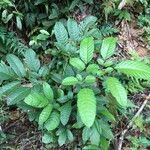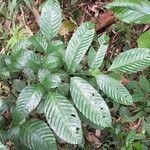Erect shrubs to small trees. Branchlets terete, longitudinal ridges obtuse, glabrous. Leaves 2-or 3-pinnate, glabrous; stipules broadly obovate, 2.5-4.5 × 2-3.5 cm, apex rounded, glabrous; petiole 13-23 cm, central petiolules 2-5 cm, lateral petiolules shorter, 0.2-0.5 cm, glabrous; leaf axis 14-30 cm, glabrous; leaflets elliptic, elongate elliptic, or elliptic-lanceolate, 6-32 × 2.5-8 cm, base rounded, or rarely broadly cuneate, margin with irregular or slightly regular teeth, teeth sharp, apex acuminate or caudate; lateral veins 6-11 pairs, abaxial veinlets conspicuous but not protruding. Inflorescences opposite to leaves, compound dichasial or umbelliform; peduncle 1-2 cm, with brown hairs. Involucre elliptic-lanceolate, ca. 0.8 × 0.3-0.8 cm, apex acuminate, glabrous; bracts oval elliptic-lanceolate, 3-4 × 2.5-3 mm, apex shortly acute and acuminate, glabrous, deciduous. Pedicel 1-2 mm, ferruginous pubescent; buds 1.5-2 mm, apex suborbicular. Calyx tube urceolate; sepal triangular, glabrous. Petals elliptic, 1.8-2.5 mm, glabrous, white or greenish white. Staminodial tube 0.5-1 mm, with lower fused part 0.2-0.3 mm, upper 0.3-0.7 mm, lobes 0.1-0.2 mm. Stamens 5; filaments 0.5-0.8 mm; anthers elliptic, 0.8-1.5 × 0.4-0.8 mm. Ovary globose; style 0.5-0.7 mm; stigma expanded slightly. Berry 0.8-1 cm in diam., 4-6-seeded. Fl. Apr-Jul, fr. Aug-Dec. 2n = 24.
A slender shrub. It grows 1-3 m tall and spreads 0.3-1 m wide. The stems are pithy. The young growth is pale green. The leaves are 30-60 cm long. The leaves are compound. They have leaflets along the stalk. The leaves can be divided 2-3 times. The leaflets are 6-25 cm long by 2-5 cm wide. The leaflets are glossy and have teeth along the edge. The leaflets have distinctive veins. The flowers are in groups 10-20 cm across and with many branches. The flowers are 0.4 cm across and green or cream. The fruit are berries 0.5 cm long and black.



